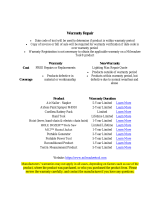
MN-1023
4
C. Introduction
NOTE
LoadLifter 5000 Ultimate
The purpose of this publication is to assist with the installation, maintenance and
troubleshooting of the LoadLifter 5000 Ultimate air spring kit. LoadLifter 5000 Ultimate
utilizes sturdy, reinforced, commercial grade single or double, depending on the kit,
convolute bellows. The bellows are manufactured like a tire with layers of rubber and
cords that control growth. LoadLifter 5000 Ultimate kits are recommended for most 3/4-
and 1-ton pickups and SUVs with leaf springs and provide up to 5,000 pounds of load
leveling support with air adjustability from 5-100 PSI. The kits are also used in motor
home rear kits and some motor home fronts where leaf springs are used.
It is important to read and understand the entire installation guide before beginning
installation or performing any maintenance, service or repair. The information here
includes a hardware list, tool list, step-by-step installation information, maintenance
guidelines and operating tips.
Air Lift Company reserves the right to make changes and improvements to its products
and publications at any time. For the latest version of this manual, contact Air Lift
Company at (800) 248-0892 or visit airliftcompany.com.
IMPORTANT SAFETY NOTICE
The installation of this kit does not alter the gross vehicle weight rating (GVWR) or
payload of the vehicle. Check your vehicle’s owner’s manual and do not exceed the
maximum load listed for your vehicle.
Gross vehicle weight rating: The maximum allowable weight of the fully loaded vehicle
(including passengers and cargo). This number — along with other weight limits, as
well as tire, rim size and inflation pressure data — is shown on the vehicle’s Safety
Compliance Certification Label.
Payload: The combined, maximum allowable weight of cargo and passengers that the
truck is designed to carry. Payload is GVWR minus the base curb weight.
NOTATION EXPLANATION
Hazard notations appear in various locations in this publication. Information which is
highlighted by one of these notations must be observed to help minimize risk of personal
injury or possible improper installation which may render the vehicle unsafe. Notes are
used to help emphasize areas of procedural importance and provide helpful suggestions.
The following definitions explain the use of these notations as they appear throughout
this guide.
INDICATES IMMEDIATE HAZARDS WHICH WILL RESULT IN SEVERE PERSONAL
INJURY OR DEATH.
INDICATES HAZARDS OR UNSAFE PRACTICES WHICH COULD RESULT IN SEVERE
PERSONAL INJURY OR DEATH.
INDICATES HAZARDS OR UNSAFE PRACTICES WHICH COULD RESULT IN DAMAGE
TO THE MACHINE OR MINOR PERSONAL INJURY.
Indicates a procedure, practice or hint which is important to highlight.
DANGER
CAUTION
WARNING
The purpose of this publication is to assist with the installation, maintenance and
troubleshooting of the LoadLifter 5000 Ultimate air spring kit. LoadLifter 5000 Ultimate
utilizes sturdy, reinforced, commercial grade single or double, depending on the kit,
convolute bellows. The bellows are manufactured like a tire with layers of rubber and
cords that control growth. LoadLifter 5000 Ultimate kits are recommended for most 3/4-
and 1-ton pickups and SUVs with leaf springs and provide up to 5,000 pounds of load
leveling support with air adjustability from 5-100 PSI. The kits are also used in motor
home rear kits and some motor home fronts where leaf springs are used.
It is important to read and understand the entire installation guide before beginning
installation or performing any maintenance, service or repair. The information here
includes a hardware list, tool list, step-by-step installation information, maintenance
guidelines and operating tips.
Air Lift Company reserves the right to make changes and improvements to its products
and publications at any time. For the latest version of this manual, contact Air Lift
Company at (800) 248-0892 or visit airliftcompany.com.
IMPORTANT SAFETY NOTICE
The installation of this kit does not alter the gross vehicle weight rating (GVWR) or
payload of the vehicle. Check your vehicle’s owner’s manual and do not exceed the
maximum load listed for your vehicle.
Gross vehicle weight rating: The maximum allowable weight of the fully loaded vehicle
(including passengers and cargo). This number — along with other weight limits, as
well as tire, rim size and inflation pressure data — is shown on the vehicle’s Safety
Compliance Certification Label.
Payload: The combined, maximum allowable weight of cargo and passengers that the
truck is designed to carry. Payload is GVWR minus the base curb weight.
NOTATION EXPLANATION
Hazard notations appear in various locations in this publication. Information which is
highlighted by one of these notations must be observed to help minimize risk of personal
injury or possible improper installation which may render the vehicle unsafe. Notes are
used to help emphasize areas of procedural importance and provide helpful suggestions.
The following definitions explain the use of these notations as they appear throughout
this guide.
INDICATES IMMEDIATE HAZARDS WHICH WILL RESULT IN SEVERE PERSONAL
INJURY OR DEATH.
INDICATES HAZARDS OR UNSAFE PRACTICES WHICH COULD RESULT IN SEVERE
PERSONAL INJURY OR DEATH.
INDICATES HAZARDS OR UNSAFE PRACTICES WHICH COULD RESULT IN DAMAGE
TO THE MACHINE OR MINOR PERSONAL INJURY.
Indicates a procedure, practice or hint which is important to highlight.
DANGER
CAUTION
WARNING























